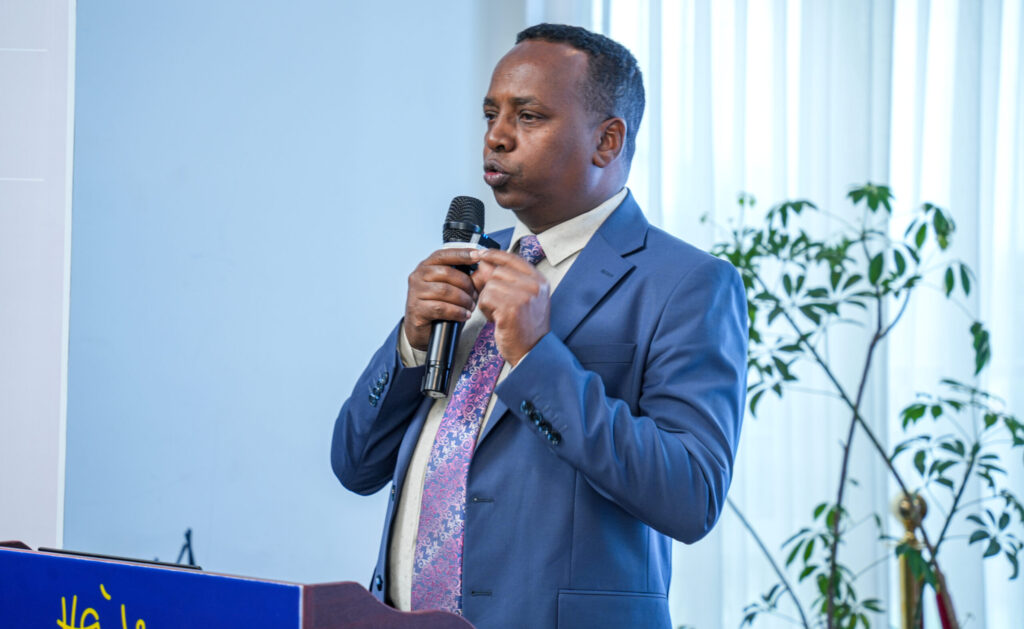Much of the Horn of Africa is desert. Ethiopia is the green exception, despite its location at the geographical centre of the region. Nicknamed the ‘water tower of Africa’, Ethiopia is home to more than 10 large hydroelectric dams, which account for 92% of the country’s electricity production. At the same time, the country aims to provide access to electricity for the entire population by 2025. Currently, about 55% of the population has access to electricity.
In October 2024, the Ethiopian-German Energy Cooperation in cooperation with the PtX Hub and the Ethiopian Ministry of Water and Energy (MoWE) hosted a two-day training for around 30 government officials and private sector experts to support the development of Ethiopia’s Power-to-X strategy.

State Minister for Energy Development, H.E. Dr Ing Sultan Wali, and Stephan Lidsba, Coordinator of the Climate Change Cluster of GIZ Ethiopia, handed over the training certificates to the participants. 
Around 30 participants from Ethiopia’s public and private sectors attended the training.
Creating a shared vision for 2050
Following an in-depth presentation by Torsten Schwab, Director of the PtX Hub, on Power-to-X production processes, storage and transport, economics, policy and sustainability dimensions, the participants jointly developed their vision for Power-to-X in Ethiopia. Green ammonia for e-fertiliser production – to reduce import dependency – and Sustainable Aviation Fuel (SAF) production with Ethiopian Airlines as an off-taker were at the heart of the discussions. Done right, it could improve the balance of trade, create jobs, and contribute to Ethiopia’s, the region’s and the world’s carbon-neutral and green development ambitions. Central to the vision is the goal of leveraging the momentum and investment interest behind Power-to-X to achieve Ethiopia’s plans for increased energy access and improved water management.
By strategically substituting commodity imports such as fertiliser and methanol with domestically produced green alternatives, Ethiopia can create new industrial production, mitigate supply risks and reduce uncertainties associated with market price volatility. Domestic production and processing of green hydrogen into these value-added products is a promising way to unlock sustainable manufacturing opportunities and drive industrialisation in the country, in line with Ethiopia’s Vision 2030 goals of universal energy access and becoming a middle-income economy.
Kaleb Tadesse, Lead Executive Officer on the Energy Resource Study at the Ministry of Water and Energy (MoWE)

Kaleb Tadesse, Lead Executive Officer
Energy Resource Study at MoWe set the scene for the training by providing an update on MoEW’s strategy development for Power-to-X.
Torsten Schwab, Director of the PtX Hub, provided in-depth training on Power-to-X technologies, economics, policy, sustainability and other topics.
Leveraging Power-to-X for energy access and water management
How could this be done? One innovative solution is to install floating solar PV panels on Ethiopia’s many lakes and dams. The panels can simultaneously produce renewable electricity for homes and factories, and for green hydrogen plants. At the same time, the panels’ shade on the water surface prevents excessive water evaporation from direct sunlight. This contributes to the Ethiopian government’s priority of protecting its abundant water resources from rising temperatures and erratic weather patterns caused by climate change.
The potential of Power-to-X is that it can act as a development accelerator for access to electricity and water management. Especially if it is intelligently combined with agrivoltaics. This means using land to simultaneously produce crops and generate electricity through photovoltaics.
Torsten Schwab, Director PtX Hub
Green ammonia for e-fertiliser to reduce import dependence
A robust strategy for decoupling Ethiopia from the volatile global fertiliser markets, which are heavily dependent on geopolitical relations, was of high interest to the experts attending the workshop. As 85% of Ethiopians are farmers, fertiliser accounts for a significant proportion of the country’s imports. Most of these fertilisers are currently neither produced sustainably, nor sourced from stable trading partners, nor at fair and reliable prices. The prospect of producing ammonia and ammonia-derived fertilisers directly in the country is therefore attractive and can become a national priority.
The main host of the training, State Minister for Energy Development, H.E. Dr Ing Sultan Wali, also emphasised in his address to the participants that Ethiopia’s renewable energy potential can and should be harnessed for the domestic production of e-fertiliser. Power-to-X offers available solutions for domestic production – using Ethiopia’s renewable electricity, water, abundant nitrogen from the air and, of course, the technology and expertise to operate it.

State Minister for Energy Development, H.E. Dr Ing Sultan Wali, motivated the participants in a short speech to keep the momentum going after the training.
Sustainable Aviation Fuels for Ethiopian Airlines
Ethiopian Airlines has an extensive fleet connecting Africa and the world. The international carrier has already entered into a strategic partnership on Sustainable Aviation Fuels (SAF), demonstrating its commitment to becoming a leader in the transition to green aviation. The International Civil Aviation Authority (ICAO) has designated the Ethiopian Aviation University in Addis Ababa as a Regional Training Centre of Excellence. The university is also an International Air Transport Association (IATA) Accredited Training School (ATS). Ethiopia thus has a well-positioned aviation sector that can drive the transition to sustainable aviation and capitalise on Ethiopia’s position as a regional and international hub.

Participants brainstormed and designed their vision with Power-to-X for Ethiopia. 
The working group focusing on Sustainable Aviation Fuels sketched out a stakeholder map.
Turning the vision into reality
Building on the momentum of all participants and the high-level encouragement of the State Minister for Energy Development, H.E. Dr Ing Sultan Wali, and Stephan Lidsba, Climate Change Cluster Coordinator of GIZ Ethiopia, one of the next steps is to define a baseline assessment and in-depth analysis of the status quo in terms of renewable energy potential, infrastructure, water resources and stakeholder engagement. It is now crucial to define an informed, realistic, and yet ambitious way forward.

Stephan Lidsba, GIZ Ethiopia’s Climate Change Cluster Coordinator, emphasised GIZ’s continued support to advance Ethiopia’s Power-to-X ambitions. 
Samson Tolessa, Head of the Secretariat of the Ethiopian-German Energy Cooperation, closed the training with a positive assessment of the progress made during the two days of training.
